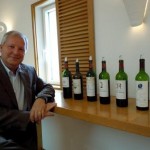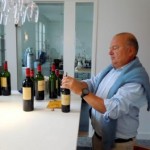Bordeaux 2010: rich, dark wines from the dry, bright sun
November 8, 2010
Note: a version of this article appeared in the 5 November issue of Harpers Wine & Spirit
By Panos Kakaviatos
After having sampled freshly fermenting wines from Medoc clients, Christophe Coupez of the Centre Œnologique de Pauillac used words like ‘black, aromatic and rich’ in a report dated 28 October. ‘They get richness from the maceration and exude surprising aromatics of black olive and cacao,’ he said of the Merlots. ‘The Cabernets are elegant and fine; with delicious, granular and chalky tannins’ and flavours that remind him of ‘vanilla-flavoured rice pudding’. Bordeaux University oenologist-consultant Nicolas Vivas [not associated with the Pauillac lab] is particularly charmed by the Merlots: ‘They are gourmand, like eating cakes with a lot of cream,’ he said. Although he encountered Merlots reaching 16 degrees, something he has never seen before – he is ‘sure that there will be some monsters’ made in 2010 – he is not bothered by high alcohol levels overall, because there is ‘such clarity of fruit and good acidity,’ he explained.
Also on October 28, Francois Brehant, winemaking director at Château Léoville Barton in St Julien, had just finished tasting various vats with Medoc wine consultant Eric Boissenot. He admitted to the pleasure tasting the vats: ‘Even more than last year at this time.’
Alcohol levels are higher than last year’s overall – ‘by half a degree,’ remarked Boissenot, who works with his father Jacques in Lamarque and consults famous estates including Mouton Rothschild, where winemaking director Philippe Dhalluin remarked that ‘Merlots at 15 degrees are not rare, and Cabernets approach 14 degrees.’ But enough acidity provides balance and powerful tannins are present, too, said Dhalluin, who compares 2010 at this very early stage to ‘1986 or 1996, but probably better.’
At Brane Cantenac in Margaux, as with most properties across Bordeaux, the harvest took place under sunny skies. Dry summer weather kept vines healthy, noted Maria Martinez Ojeda, quality consultant for the 2nd growth. The Merlots were ‘great, with big, luscious fruit, density, an intense robe and good acidity,’ she said.
Much sun, little rain
Near record sunlight yielded wines rich in anthocyans [pigments responsible for red colours in wine], remarked Jean-Claude Berrouet of Petrus in Pomerol. Sunlight hours surpassed the 20-year average by almost 50% in September: 243 hours as opposed to the average of 182, he said. July and August saw more sun than average. Berrouet likes to make red, not black wines. ‘But dark colours came naturally in 2010.’ Unlike 2003, fresh nights and even cool temperatures helped maintain acidity. World famous wine consultant Michel Rolland called 2010 ‘a record for the amount of anthocyans.’
Another critical element: rain. Only 362mm of rain fell in 2010, as opposed to 483mm in 2009, according to Didier Cuvelier of Château Léoville Poyferré in St Julien. The weather led to smaller-than-average berries, concentrated juices and those deep colours. By the end of August, both Jacques and Eric Boissenot worried that if rain did not fall ‘by 10 September’ they would have advised clients to pick at less than full phenolic maturity, risking greenness in the wines. ‘The vines had started to suffer from lack of water,’ said Philippe Delfaut of Château Kirwan in Margaux. The week of 6 September, 25mm of rain fell across much of the Medoc, and between 15mm and 35mm in Saint Emilion and Pomerol. It came in the nick of time to halt hydric stress, and just enough not to dilute the grapes. ‘We were concerned that some parcels might struggle to reach maturity,’ explained Delfaut, ‘however the light but persistent rainfall penetrated the soil, allowing the grapes to fully ripen.’
Less volume
April and May had been rather cool and rainy. By the time of flowering for Merlot, some hot weather mixed with rainfall resulted in coulure (or ‘shatter’, where the grapes do not develop well after flowering). Uneven flowering was interrupted by mid-June showers. The problematic weather did not affect the Cabernets as much, but left vintners with less Merlot. Léoville Barton, for example, is planted with about 80%Cabernet Sauvignon and 20% Merlot, but the blend will possibly have more Cabernet, remarked Brehant.
2010 will not favour one variety over another, most said. The accent is on terroir. ‘Northern exposure was better in 2010, because it got less sun,’ said Pascal Delbeck of Château Tour du Pas St. Georges near St Emilion. ‘Cooler soils proved more favourable, such as limestone and clay, in the face of the dry weather.’ The end result will be wines with 14.2 to 14.5 natural alcohol, he said. ‘Rather strong, yes, but it may miss some elegance – a wine for our friend Bob,’ he quipped, referring to Robert Parker.
Consultants advised clients to soft peddle extraction. Already by 13 September, Coupez in Pauillac had sent his 300 clients a six-point checklist: ‘harvest the grapes as cool as possible, at night or very early in the morning’ and ‘maintain cool temperatures during fermentation,’ among other points. Vivas, who works with many classified growths, called for ‘modesty’ in interventions and avoiding ‘too much contact with oxygen, meaning less racking.’
Because of small berries and less Merlot, 2010 will produce about 20% less wine than last year, said Eric Boissenot. At Château Le Crock in St. Estephe, also owned by Cuvelier, almost the same number of grapes were harvested as last year, he said, but their sizes were so small that ‘we ended up with one tank less of 120 hl.’
At this early stage, it is difficult to say how the wines will taste. Echoing Vivas’ ‘creamy cakes’ comparison, Berrouet cautioned against extracting too much. ‘When you have a rich plate of food, you do not want a second serving.’ He said that 2010 promises to be a fine follow up to 2009, like 1990 was to 1989. Similar words from the Left Bank: ‘It looks like a great vintage in terms of tannin, colour and alcohol,’ remarked Cuvelier. ‘We have another trilogy (2008-2009-2010 as to 1988-1989-1990).’
Vivas thinks 2010 will not last as long as 2009. ‘It will be a vintage that one should drink young; it will be most impressive in its youth,’ he said. ‘2009 will prove to be a far better vintage because it is more complete, and everything was in the right proportion, with better balance between tannins of the skins and tannins of the pips. In 2010, there was less margin for manoeuvre.’
Postscript: Take note that any judgment on 2010 can only be made next spring, and even then, with much trepidation; proof is in bottle, so it will be interesting to see how the 2010s taste from barrel, then from bottle. At least from what people are saying in Bordeaux, 2010 should pack some punch and taste! It would be nice, too, to see a drop in price …



